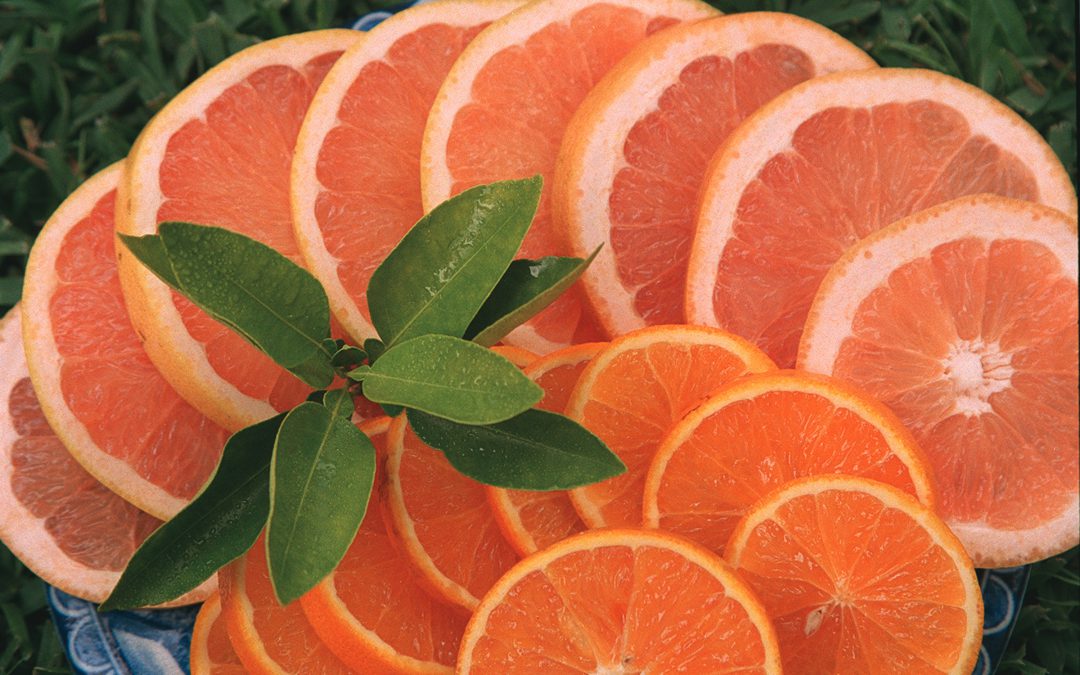
by Ray Bodrey | Apr 8, 2021
The Sunshine State produces a wide selection of citrus, with a number of varieties that can be grown right here, in your Panhandle dooryard. And, what is more satisfying than picking fresh fruit from your very own trees? So, are you looking for a different variety to plant? The ‘Parson Brown’ sweet orange may be of interest. It can certainly add uniqueness to your dooryard citrus grove.
Originating in China, orange varieties began being introduced in Europe in the fifteenth century. As for introduction to America, Columbus brought orange seeds to the new world on his second voyage in 1493. The first plantings in Florida were around 1513 in the settlement of St. Augustine. For the ‘Parson Brown’, a chance seedling originated at the home of Reverend N.L. Brown near Webster in 1856. Sumter and Seminole counties are still home to some of the largest densities of ‘Parson Brown’ orange trees in the state.
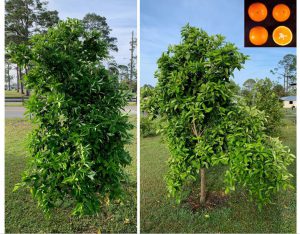
Figure 1: ‘Parson Brown’ Sweet Orange. Credit: D.P.H. Tucker, Ray Bodrey, UF/IFAS.
The Parson Brown, however, is often overlooked. The most popular dooryard sweet orange varieties grown throughout Florida are Navel, Hamlin, Valencia and Pineapple. Availability of this variety in our region is not easily found either, as you may have to search to find a tree.
Unlike the short, round appearance of many citrus trees, the Parson Brown tends to grow tall and slim. The Parson Brown’s more upright tree structure is very distinctive. A specimen will certainly stand out in a grove. The fruit and yield rival a Hamlin orange, particularly when grown in heavy, hammock soils rather than sandy soils with low organic content. The variety is also not as marketable as the Hamlin on a commercial level, due to the heavier seediness. You can expect at least 10 seeds per fruit. Average diameter of fruit is between 2 ½” to 2 ¾”. Harvest season for fruit is generally between October and January. Evidence suggests that along with the ‘Sugar Belle’ variety, the ‘Parson Brown’ may be more disease resistant, specifically more tolerant to citrus greening. HLB or citrus greening is a disease that has devastated both commercial production and dooryard citrus across the state.
Contact your local county extension office for more information. Also, for more information on growing citrus in Florida, see the UF/IFAS Extension EDIS publication, “Citrus Culture in the Home Landscape” by Robert E. Rouse and Mongi Zekri.
UF/IFAS Extension is an Equal Opportunity Institution.
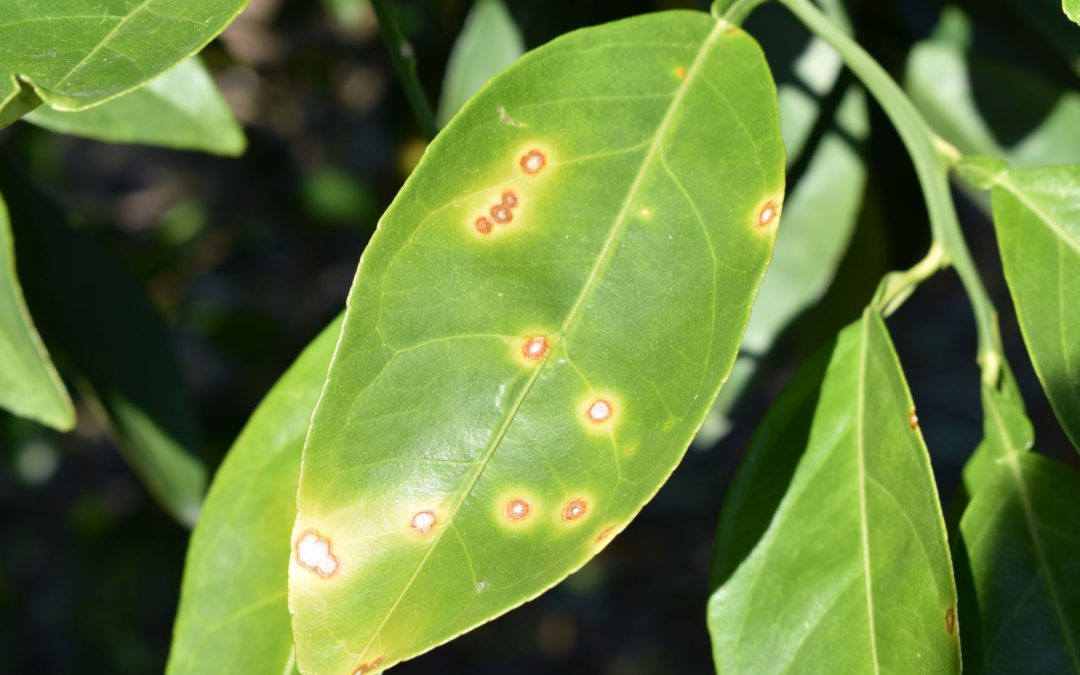
by Mary Salinas | Apr 1, 2021
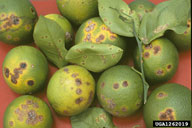
Citrus canker symptoms on twigs, leaves and fruit. Photo by Timothy Schubert, FDACS
Citrus canker was found for the first time in the Florida panhandle in Gulf Breeze in southern Santa Rosa County in November 2013. Since that time, citrus canker has spread widely in the Gulf Breeze area and just recently in 2020 was found in two locations in Panama City and Panama City Beach in Bay County.
Citrus canker is a serious bacterial disease that only infects citrus trees. It will not infect any other plant species nor is it a threat to human health. Severely affected trees experience substantial leaf loss and premature fruit drop and serve as a source for infecting nearby citrus. The disease spreads through wind, rain, and transportation of infected plant material from other locations.
This highly contagious disease has no cure although progression of the disease can be slowed through the use of copper-based products. This publication guides the homeowner on using copper.
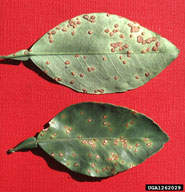
Citrus canker lesions on leaves are raised, rough and visible on both sides of the leaf. Photo by Timothy Shubert, FDACS.
Not all citrus varieties are equally susceptible to this disease. Grapefruit, lemon, and lime are some of the most vulnerable while tangerine and tangelo varieties are among the most resistant.
What should you do if you suspect your citrus is infected with this disease?
- Look at this guide for more information and compare the symptoms on your tree to the photos. Lesions on the leaves penetrate through the leaf so they are visible on the upper and lower leaf surfaces, are rough, and have a yellow halo. The lesions look similar on the fruit and stems. Lesions (or cankers) on the stems usually indicate a longer standing infection of a year or more.
- Consult your local Horticulture Extension Agent to confirm the diagnosis and obtain more information and control/removal strategies.
- Proper removal of infected trees is recommended to prevent the spread of citrus canker but is not mandatory. The best way to dispose of infected trees is through cutting them down and burning them onsite; this ensures than none of the plant material leaves your yard to infect other areas. Consult your local burn regulations before burning. Stray leaves, branches and fruit should be raked and burned or double bagged for the trash. Please avoid disposing of any of your citrus trees by putting them by the side of the road for pickup by the county yard waste recycling or regular waste disposal. The bacterium will survive in the plant tissue and be spread to other neighborhoods in the county. You can, however, double bag infected plant material in sturdy bags and place it in the trash.
For more information please see:
UF IFAS Gardening Solutions: Citrus
Citrus Culture in the Home Landscape
UF IFAS Extension Online Guide to Citrus Diseases

by Danielle S. Williams | Mar 4, 2021
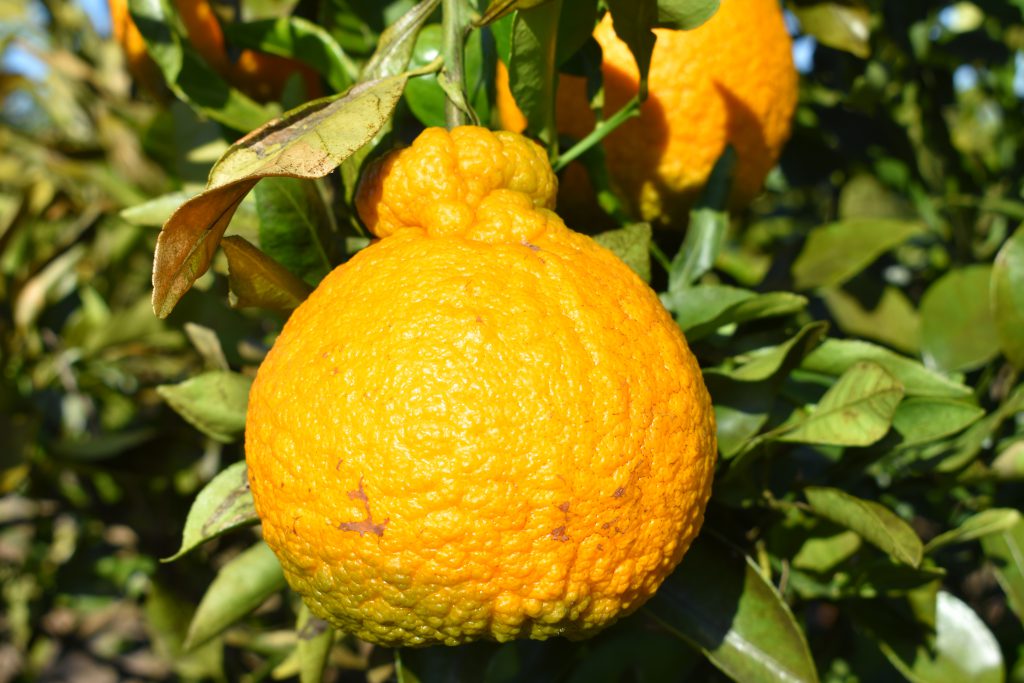
Shiranui mandarin
You’ve likely seen them in the grocery stores, and you’ll see them now through April. A large, lumpy (some may say ugly) piece of orange fruit with a bump near the stem. But what exactly is this special looking fruit? It’s a Shiranui mandarin!
The name ‘Shiranui’ is the generic term for this variety of citrus. You may have seen the same variety of mandarin marketed in grocery stores as ‘Sumo Citrus’ which is a trademarked name for the variety. In Japan, they are widely known as ‘Dekopons’. No matter what you call them, they are easily recognized by their distinctive appearance.
The Shiranui mandarin is a hybrid between a Ponkan tangerine and a Kiyomi Tangor (sweet orange x satsuma mandarin). They are easy to peel, sweet, and seedless. Shiranuis are considered to be one of the sweetest and most flavorful varieties of citrus on the market. The fruit are large and have a large protruding bump near the stem that resembles the top knot hairstyle of a Japanese sumo wrestler (hence the trademarked name ‘Sumo Citrus’).
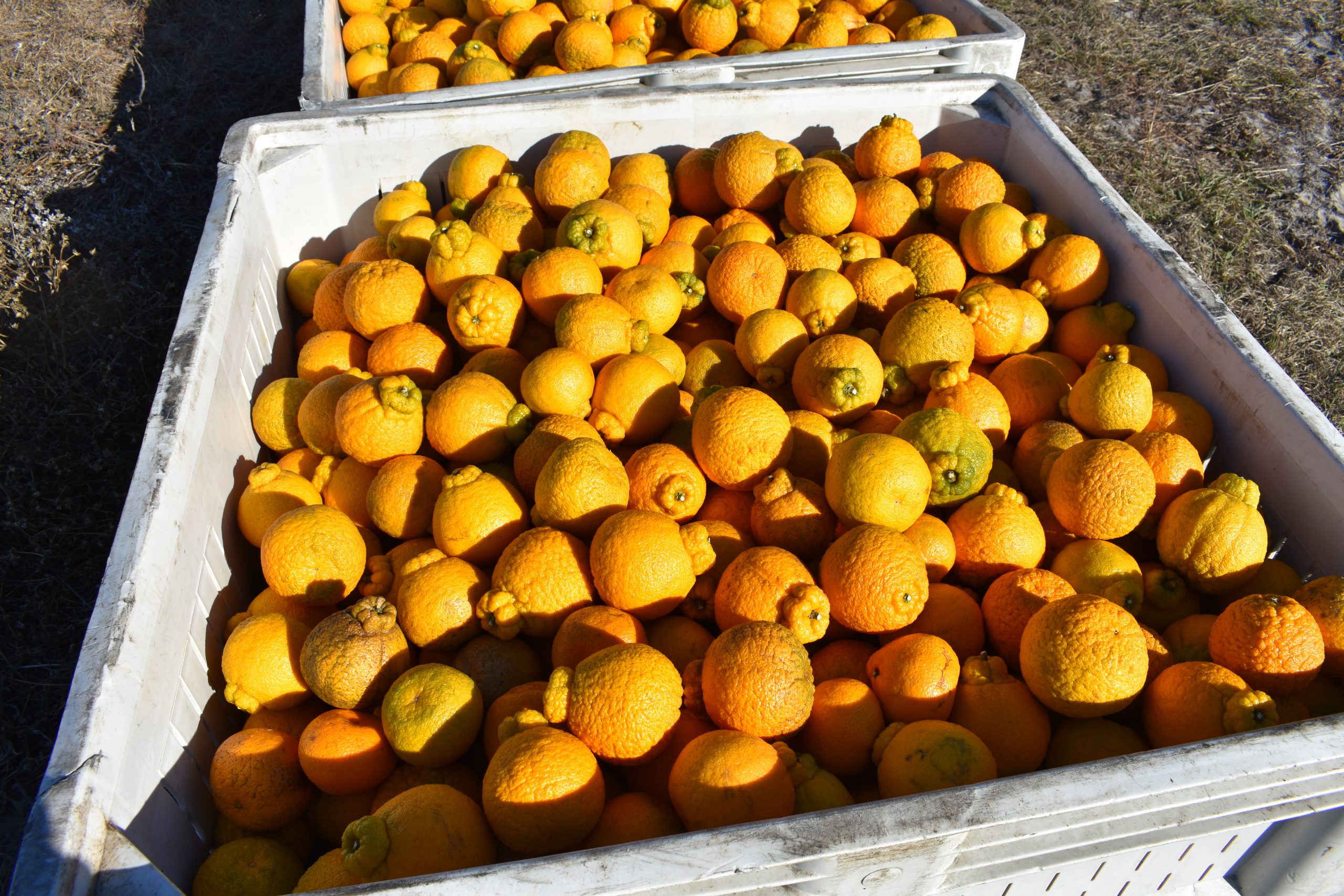
While the majority of Shiranui mandarins on the market are grown in California, the variety can be grown here in Florida and several citrus growers in North Florida and South Georgia have began to experiment with plantings in the region. Homeowners, too, can try their hand at growing the variety as many Florida certified citrus nurseries carry the variety. For more information on different citrus varieties, contact your local UF/IFAS Extension Agent.
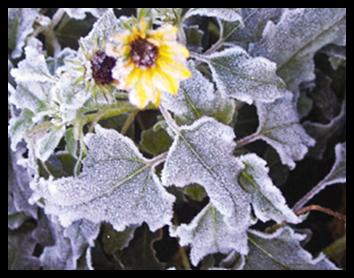
by Sheila Dunning | Dec 4, 2020
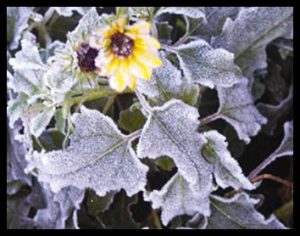
Frost on Dune Sunflower
Picture by: Pam Brown
UF/IFAS Extension
December is finally here and that means consistent nights of watching for dropping temperatures. Tropical plants and newly installed shrubs are susceptible to cold injury. Those colorful, blooming plants that have added a tropical look to the landscape all summer may begin to suffer when the temperatures drop below 500 F. Leaves may turn yellow and flowering stops. These plants will need to be moved inside or have temporary greenhouse built around them. But, hardy plants that haven’t established a sufficient root system will also need additional attention when the temperatures drop dramatically.
The ability of plants to endure a freeze depends on the species and the weather leading up to the extra cold night. Gradual decreases in temperatures helps plants acclimate to winter. But, a sudden one day drop of 40-50 degrees results in a rapid freeze that causes ice to form inside the plant cells. Leaf and stem tissue expands so quickly that it splits, resulting in parts of the plant incapable of transporting water and nutrients, as well as, performing photosynthesis. However, it may be late the following spring before the damage is noticed, when that section of the plant has slowly staved to death.
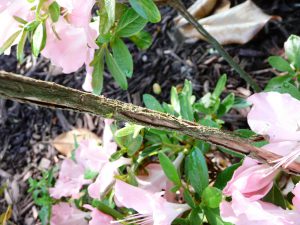
Cracked bark from frost
Additionally, plants can experience desiccation or drying out. This happens when dry winds and solar radiation result in the loss of more water from the leaves than can be transported by a cold root system. The resulting symptom is marginal and/or tip burning of leaves that leads to totally brown leaves.
Freezes (when the temperature drops to 320 F) are characterized as radiational or advective. Radiational freezes occur on calm, clear nights when heat radiates from the surfaces of plants, making them colder than the air due to the rapid loss of heat. If there is moisture in the air, ice will also form on the surfaces. Under these conditions, ice forms between plant cells, rather than within the individual cells. Most hardy plants can tolerate these type of freezes if they are properly hydrated.
Advective freezes occur when cold northern winds move in rapidly, dropping temperatures quickly, and causing widespread foliage desiccation. Cultivation and maintenance practices can impact a plant’s ability to endure extended periods of low temperatures. Shade-tolerant species installed under the canopy of a tree typically display less injury from radiational freezes because the trapped heat from the ground and the overhead foliage creates a microclimate. Well-watered soil around a plant will absorb solar radiation during the day and re-radiate heat over night, raising the temperature around the plants. Shrubs that are not pruned in the late summer or fall have leaves that can withstand frost and wind. But, the removal of foliage late in the growing season triggers a flush of new growth, that is very sensitive to lower temperatures. The same response can result from fertilizer applications after plant’s have slowed down in growth.
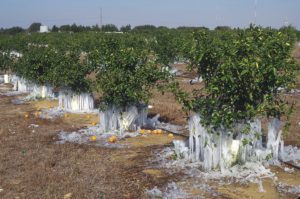
Irrigation Frost Protection on Citrus
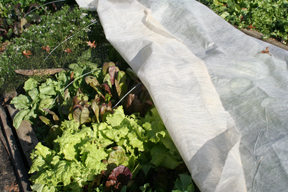
Row Cover
Picture by: Univ of Maryland Extension
So, what can you do to prepare for upcoming freezing temperatures? Begin by avoiding pruning and fertilizing at the end of the season and making sure that the plants have been watered within 24 hours of a cold night. Next, insulate against water loss and increase heat radiation by adding a three-inch of mulch, as well as, covering the trunks of sensitive trees with a commercial tree wrap. Then, consider what needs to be covered. Frost cloth or other breathable fabrics can trap heat for the night and provide a protective layer from frost settling on the leaves. It needs to be placed by mid-afternoon and removed the next day when temperatures are above 320 F. Plastic is not recommended unless the timing regime can be followed reliably and a structure is used under the material to keep the plastic off the foliage. Anchoring of the cover is critically important in the event of an advective freeze.
Finally, turn off the sprinkler system. Commercial agriculture often uses a running irrigation system to keep the leaf surface temperatures near, but not below, 320 F because sprinkling utilizes latent heat released when water changes from a liquid to a solid state. The thin layer of ice melts and re-freezes on the surface throughout the night, without ice forming within the plant tissues. For the technique to work, sprinkling must begin as freezing temperatures are reached and continue until thawing is complete. Landscape systems are not designed to deliver the amount of water over the length of time required to accomplish this type of frost protection.
When the cold nights have passed, don’t forget to check your plants for water. But, wait until winter has passed before pruning out the frost damaged stems.
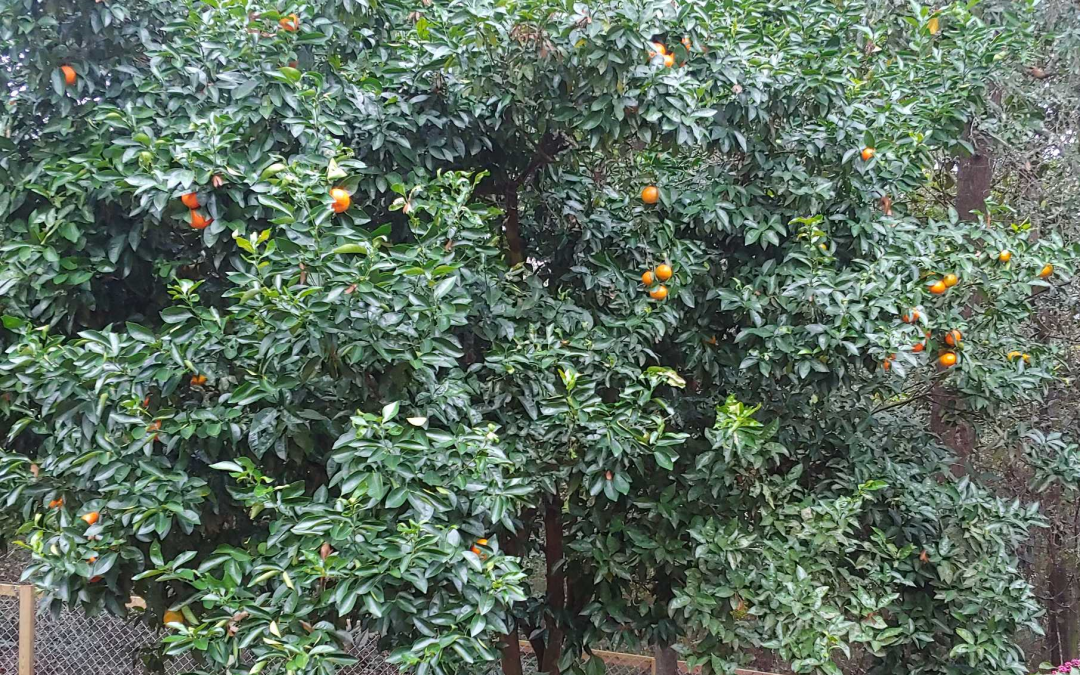
by Matt Lollar | Nov 4, 2020
From time to time we get questions from clients who are unsatisfied with the flavor of the fruit from their citrus trees. Usually the complaints are because of dry or fibrous fruit. This is usually due to irregular irrigation and/or excessive rains during fruit development. However, we sometimes get asked about fruit that is too sour. There are three common reasons why fruit may taste more sour than expected: 1) The fruit came from the rootstock portion of the tree; 2) The fruit wasn’t fully mature when picked; or 3) the tree is infected with Huanglongbing (HLB) a.k.a. citrus greening or yellow dragon disease.
Rootstock
The majority of citrus trees are grafted onto a rootstock. Grafting is the practice of conjoining a plant with desirable fruiting characteristics onto a plant with specific disease resistance, stress tolerance (such as cold tolerance), and/or growth characteristics (such as rooting depth characteristics or dwarfing characteristics). Citrus trees are usually true to seed, but the majority of trees available at nurseries and garden centers are grafted onto a completely different citrus species. Some of the commonly available rootstocks produce sweet fruit, but most produce sour or poor tasting fruit. Common citrus rootstocks include: Swingle orange; sour orange; and trifoliate orange. For a comprehensive list of citrus rootstocks, please visit the Florida Citrus Rootstock Selection Guide. A rootstock will still produce viable shoots, which can become dominant leaders on a tree. In the picture below, a sour orange rootstock is producing a portion of the fruit on the left hand side of this tangerine tree. The trunk coming from the sour orange rootstock has many more spines than the tangerine producing trunks.
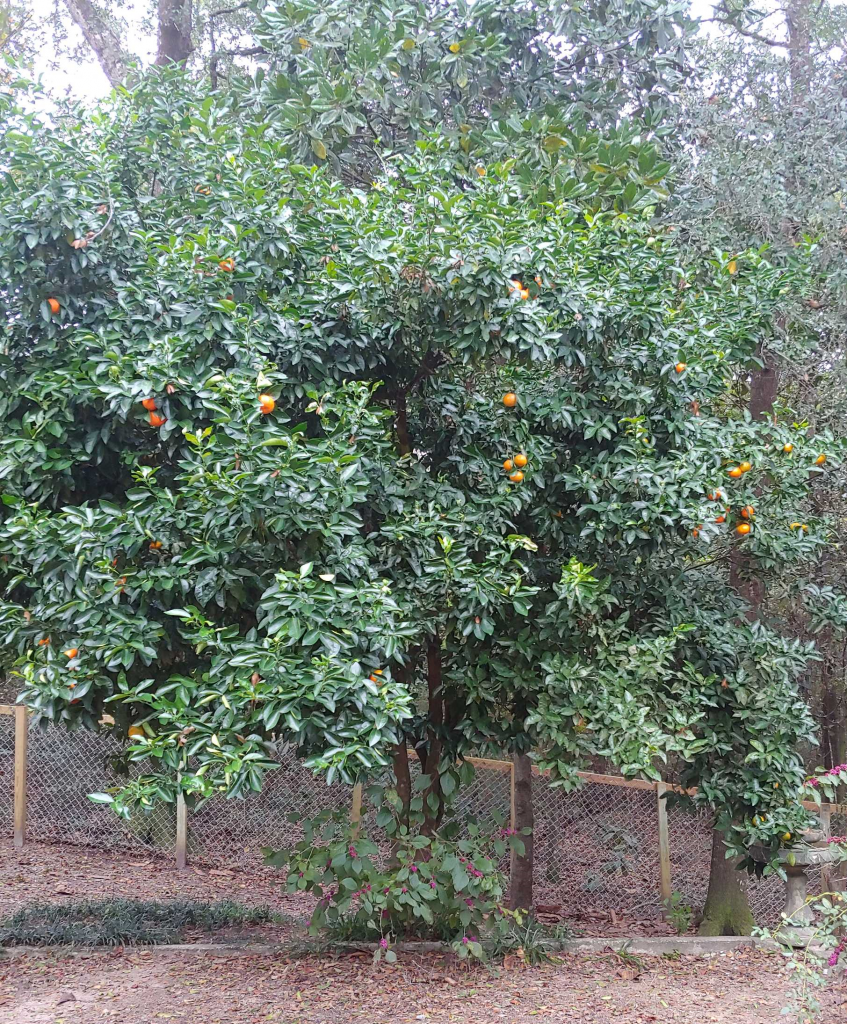
A tangerine tree on a sour orange rootstock that is producing fruit on the left hand side of the tree. Photo Credit: Matt Lollar, University of Florida/IFAS Extension
Fruit Maturity
Florida grown citrus generally matures from the months of October through May depending on species and variety. Satsumas mature in October and taste best after nighttime temperatures drop into the 50s. Most tangerines are mature in late November and December. Oranges and grapefruit are mature December through April depending on variety. The interesting thing about citrus fruit is that they can be stored on the tree after becoming ripe. So when in doubt, harvest only a few fruit at a time to determine the maturity window for your particular tree. A table with Florida citrus ripeness dates can be found at this Florida Citrus Harvest Calendar.
Citrus Greening
Citrus Greening (HLB) is a plant disease caused by the bacterium Candidatus Liberibacter asiaticus, which is vectored by the Asian citrus psyllid. The disease causes the fruit to be misshapen and discolored. The fruit from infected trees does not ripen properly and rarely sweetens up. A list of publications about citrus greening can be found at the link Citrus Greening (Huanglongbing, HLB).

A graphic of various citrus greening symptoms. Photo Credit: University of Florida/IFAS Extension

by Larry Williams | Oct 28, 2020
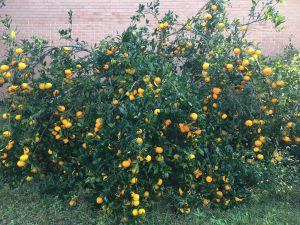
Nice fall crop of satsuma fruit. Photo credit: Larry Williams
When asked what kind of citrus to grow here in North Florida, my default response is satsuma. I usually get a funny look, followed by an attempt by the person who’s asking to repeat the name satsuma. The individual may ask, “What is satsuma… is that a citrus?” I guess the person expected to hear orange, grapefruit, lemon or maybe tangerine.
Satsuma is a type of citrus, technically classified as a mandarin and is sometimes referred to as satsuma mandarin. The satsuma mandarin is a good candidate for the North Florida citrus enthusiast for a number of reasons.
- Historically, mature dormant trees have survived minimum temperatures of 14°F to 18°F when budded/grafted to a cold-hardy rootstock such as trifoliate orange or swingle, a trifoliate orange cross. Young trees are not as cold-hardy but, due to their smaller size, are more easily covered with a cloth such as a sheet or lightweight blanket for protection during freezes.
- Satsuma fruit are ready to harvest October through December, ripening before the coldest winter temperatures. This is not true with most sweet citrus types such as oranges, which are harvested during winter months. Harvesting during winter works well in Central and South Florida where winters are mild but does not work well here in extreme North Florida. The potentially colder winter temperatures of North Florida are likely to result in the fruit on sweet oranges freezing on the tree before they are ripe, potentially ruining the fruit.
- Our cooler fall temperatures result in higher sugar content and sweeter fruit.
- Fruit are easily peeled by hand, have few to no seed and are sweet and juicy.
- Trees are self-fruitful, which means that only one tree is needed for fruit production. This is important where space is limited in a home landscape.
- Trees are relatively small at maturity, reaching a mature height of 15 to 20 feet with an equal spread.
- Branches are nearly thornless. This may not be true with shoots originating at or below the graft union. Shoots coming from the rootstock may have long stiff thorns. These shoots should be removed (pruned out) as they originate.
Satsuma fruit are harvested in fall but trees are best planted during springtime when temperatures are mild and as soil is warming. Availability of trees is normally better in spring, as well. For additional cold protection, purchase a satsuma grafted on trifoliate orange rootstock and plant the tree on the south or west side of a building. There are a number of cultivars from which to choose.
For more info on selecting and growing satsuma mandarin, contact the UF/IFAS Extension Office in your County or visit the following website.
https://edis.ifas.ufl.edu/ch116


















